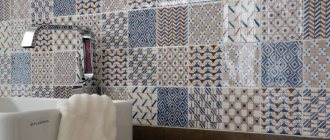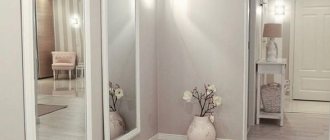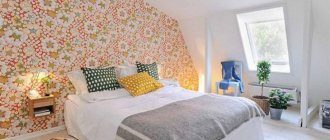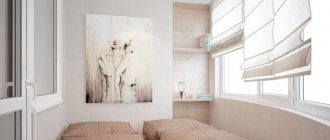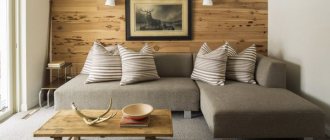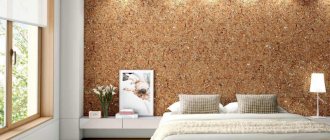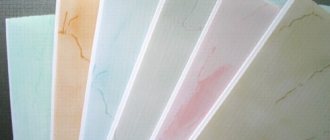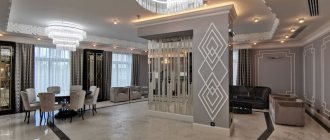Repairs are always troublesome and expensive. It is necessary that the efforts of the apartment owners are not in vain. Designers think through every smallest detail in the decoration, design, and furnishings of the apartment. Only in this case, home renovation will bring joy and satisfaction.
Before you start renovating, you need to think carefully about all the options: decide what style you like, what this or that style solution implies in the design, what furniture is suitable for each room and, of course, choose the right materials for finishing the walls, floors and ceilings. Don't have the courage to decide on something? Then you definitely need to contact the specialists of our channel and the online store Mebel169.ru, who will answer any of your questions and help you make your choice.
General recommendations for wall decoration
An incredible number of types of building materials, techniques and finishing methods greatly facilitate the entire renovation process. But you need to know a few general rules before you start remodeling.
- Environmental friendliness of materials. An important aspect that must be paid attention to. This is especially true if there are allergies in the family. And in other cases it is better if the material does not emit any toxic substances or odors.
- Fire resistance. The modern construction market offers many types of finishing materials tested for flammability, so there is plenty to choose from.
- A special approach to each room separately. Ceramic tiles on a bedroom wall will be completely out of place, and paper wallpaper in the kitchen may be impractical.
- Cost of materials. Here it is up to the owner to decide how much he is willing to spend. But remember that the most expensive is not always the best. It is quite possible to choose a high-quality budget option.
- The ease of finishing work is of no small importance, especially if you are doing the repairs yourself.
- Aesthetics. Everything must fit together, nothing can fall out of the overall design. Each type of finish suits its own style.
Wood paneling
Wood has been used in construction and decoration for centuries, and it seems that it will be relevant for a long time. All thanks to its excellent appearance and ability to regulate indoor humidity. This is perhaps the only material that will remove excess moisture without problems, regardless of what material the walls are made of.
Wooden cladding can have a completely non-standard appearance: different colors and sizes, different directions. It's simple, but the effect is amazing
The most popular materials for wall cladding are block house and imitation timber. There is also lining for exterior decoration - it is thicker than that intended for interior decoration of a house, but otherwise it is no different.
The block house imitates the surface of a rounded log - the front part has a rounded shape. Imitation timber is very similar to planed timber. Both types of cladding are attached to the sheathing, then sanded and coated with protective impregnations, and optionally varnished or painted.
What does lumber look like for exterior cladding of a house?
If you can't decide how to cover the outside of a foam block house, consider wood cladding. In this case, lathing (metal or wood) is nailed to the walls. If necessary, insulation is laid between the slats - basalt wool (foam or polystyrene foam cannot be used), and then wooden sheathing is nailed.
This building is sheathed with imitation timber. Under the skin there can be brick, log frame, frame or any of the building blocks
If you need the cheapest option, for most regions of Russia this is an ordinary planed board. Its thickness is from 40 mm, it is stuffed in the same way as a lining or block house onto the sheathing, the lower end of the upper board extends 10-20 mm onto the one located underneath it. It turns out the principle of the cone. This way you can cheaply cladding a country house or even a residential one. When properly processed, such cladding has a very good appearance.
How to cheaply cover the outside of a house? For central Russia - planed wooden boards
The disadvantages of such finishing are the same as with any wood: it can be damaged by pests, rot, without proper care it quickly loses its decorative effect, becomes dark and ugly. If you want to cover your house and not think about it for years, this is not your choice. Wooden cladding requires maintenance, and, most often, annually.
Read how to cover a house with bricks here.
Wall panels
There are also many varieties of wall panels. Each of them has its own advantages.
- Panels made of PVC are quite cheap, but at the same time they are practical: easy to clean, resistant to moisture, easy to install. Perfect for the bathroom.
- Chipboard panels (MDF ) will look good in the living room, hallway, and large hall. Their advantage is their diversity, i.e. variety of color shades.
- 3D panels are very original in their texture and aesthetics This is a tribute to modern technology. Glass, bamboo, reed, plastic, aluminum panels will create a unique interior that will impress everyone around with its unusualness.
Decorative plaster
Just ten years ago, decorative plaster was considered an exotic and expensive type of finishing. Today it is an affordable and practical type of finishing.
- Textured plaster. It is based on synthetic materials and all kinds of fillers, both artificial and natural. The relief of the plaster depends on the type of filler.
- Terrasite plaster. It contains mica - its particles seem to sparkle and shine when the sun's rays hit them. Terrazed plaster is rarely used in apartments and houses, except for accent areas.
- Latex plaster is very durable and is not afraid of mechanical stress.
- Silicate types of decorative plaster do not swell and have dirt-repellent properties.
- Venetian plaster looks like polished marble. The effect is achieved thanks to a special application technique.
- Tadelakt is another type of decorative plaster without synthetics - natural components and fillers. The material is not affected by moisture and can be used in damp areas.
Regardless of the brand, name and type, decorative plaster has one important positive property: to apply it you do not need to level the walls too carefully. It can even be applied to a rough finish: a layer of plaster will hide all the defects and unevenness of the wall, although such “putty” will become golden for you.
Decorative plaster can be applied to concrete, wood, and metal - it adheres equally well to any surface. Caring for decorative plaster is simple: wipe the walls with a damp cloth or clean them with a soft damp brush.
What rooms should I use it for? For anyone: plaster will be appropriate in the bathroom, in the kitchen, in the hallway, and in other rooms.
Self-adhesive film
Self-adhesive film may be used in some areas of the kitchen walls. This is a completely budget option. This material is only suitable for covering the surface of walls in the dining or work area. The finish does not tolerate high temperatures and begins to melt and deform.
Wall wrap filmSource www.amazon.co.jp
Venetian plaster
You can create marble walls with your own hands. Venetian plaster is used for this purpose. She creates an interesting pattern. It is practically indistinguishable from the structure of the stone. In places where the walls are curved, a defect may be observed after the coating has dried.
Beautiful kitchen in a classic style Source th.aviarydecor.com
Warm shades for a cozy interiorSource aviarydecor.com
Marble decoration with Venetian plaster is also acceptable in a classic-type interior. The gilded finish goes well with beige furniture and its decorative elements. It is the furniture fittings that emphasize the uniqueness. The plaster also harmonizes with the tiled floor. It also follows the contours of marble. Such rooms cannot do without additional decor.
Minimalism in living room design: photos of interior design options
The minimalist style is very popular when decorating a room. The living room is done in a light color palette. The room is characterized by modern multifunctional furniture, clear geometry, strict lines, simple shapes, the absence of meaningless decor, and an abundance of light. A minimalist living room is the epitome of practicality and comfort.
A room in the minimalist style is characterized by clear geometry and strict lines.
When decorating a room, the leading place is given to white and gray colors. Black halftone is often used to delimit space. You can add sunshine to your living room with soft cream tones. All natural shades and textures of wood, stone and brick fit harmoniously into the interior of the hall (the photos clearly show this). Preference is given to dark brown color, which is manifested in furniture, flooring, and decorative inserts on the walls.
An eco-trend for a minimalist living room is the use of green as the main natural shade. Olive and mint tones are suitable as a background. You can create an accent using a rich herbal color.
Decorating walls, ceilings and floors when decorating a living room in a minimalist style
The walls of the hall in the minimalist style are usually finished with decorative plaster. Brick walls or a painted concrete base will fit into the overall concept. Such deliberate carelessness in decoration will give the room a unique charm, which can be seen in real photos of the design of a living room in a Khrushchev-era building.
In minimalism, cladding panels and wallpaper are rarely used
In a room decorated in a minimalist style, you should arrange a suspended ceiling in a white or cream shade, on which it is recommended to place elements of spot lighting. With the help of a multi-level design it will be possible to zone the common space.
There are practically no decorative elements in a minimalist living room
The floor in the living room in the minimalist style is usually finished with natural stone and large ceramic tiles in light colors. The self-leveling floor will look original. Laying linoleum with a light geometric pattern is allowed. Natural wood and laminate fit best into a restrained interior. Preference is given to light bleached options.
Minimalist living room design: photos of options for transforming the room
Cabinet furniture for a living room in a minimalist style should have flat, laconic facades, glossy, polished and varnished surfaces, metal fittings, and glass inserts. It is necessary that all elements be made in a strict geometric form. Preference is given to rectangular models. Multi-tiered furniture with built-in drawers and niches fits organically into the minimalism of the living room. Ideal for the living room interior is a sofa that, when folded, turns into a wardrobe, a folding table, or a side table. For soft upholstery, leather or smooth fabric texture in subdued colors is used.
For soft upholstery, leather or smooth fabric texture in subdued colors is used.
A minimalist living room should be bathed in an abundance of natural light. Therefore, the windows are not covered with curtains. The use of Roman blinds is allowed. For additional light, spotlights, hidden lights and geometric disks are installed. A good solution is neon lighting, which creates a festive feeling in the room. Different lighting options can be seen in the photo of the design of the living room in the apartment.
A minimalist living room should be bathed in an abundance of natural light
There are practically no decorative elements in a minimalist living room. It is allowed to use several large elements reminiscent of the eastern roots of the style. The same applies to textiles. It will be enough to place several plain pillows on the sofa. When using a bedspread, preference is given to simple, inconspicuous products.
Materials for interior finishing works
When choosing a material, it is necessary to take into account what functional type the room belongs to, its operational characteristics and sanitary and hygienic requirements. In a residential area, it is necessary to use natural, breathable materials.
At the same time, they must have low thermal conductivity. If the functional use of the room requires the presence of high humidity, then you should use materials that are not afraid of moisture, which will cause fungus or mold to appear on the walls.
An important point is the ease of maintenance of the walls and their aesthetic appeal. Now we need to move on to a more detailed consideration of the materials that can be used for interior wall decoration.
Wallpaper
Today there is such a wide variety of types of such finishing that you can choose for yourself the option that will suit you in all respects.
Paper wallpaper
This option is applicable only in those rooms where microclimatic conditions require the presence of standard moisture. They are able to let in air space well, which ensures that the walls “breathe”.
There is no shortage of adhesives applied when decorating walls with wallpaper. A good point for the consumer is the affordability of the price. You can choose wallpaper with different patterns and shades.
The negative point is that they quickly fade in the sun and cannot resist moisture well enough.
Paper wallpapering requires efficiency, since the adhesive composition cannot remain on it for a long time. They will simply become limp, because their base is paper.
Textile wallpaper
The basis for them is also paper, but on top they are covered with artificial or natural canvas. A variety of colors allows you to choose a shade in accordance with your existing design solutions.
You can finish the wall with a single sheet, since rolls 3.1 m wide are available for sale.
Although textile wallpaper is quite durable, it is easy to damage it. After this they can no longer be restored. Another feature is that the sticker assumes a perfectly smooth surface. Otherwise, defects cannot be avoided.
